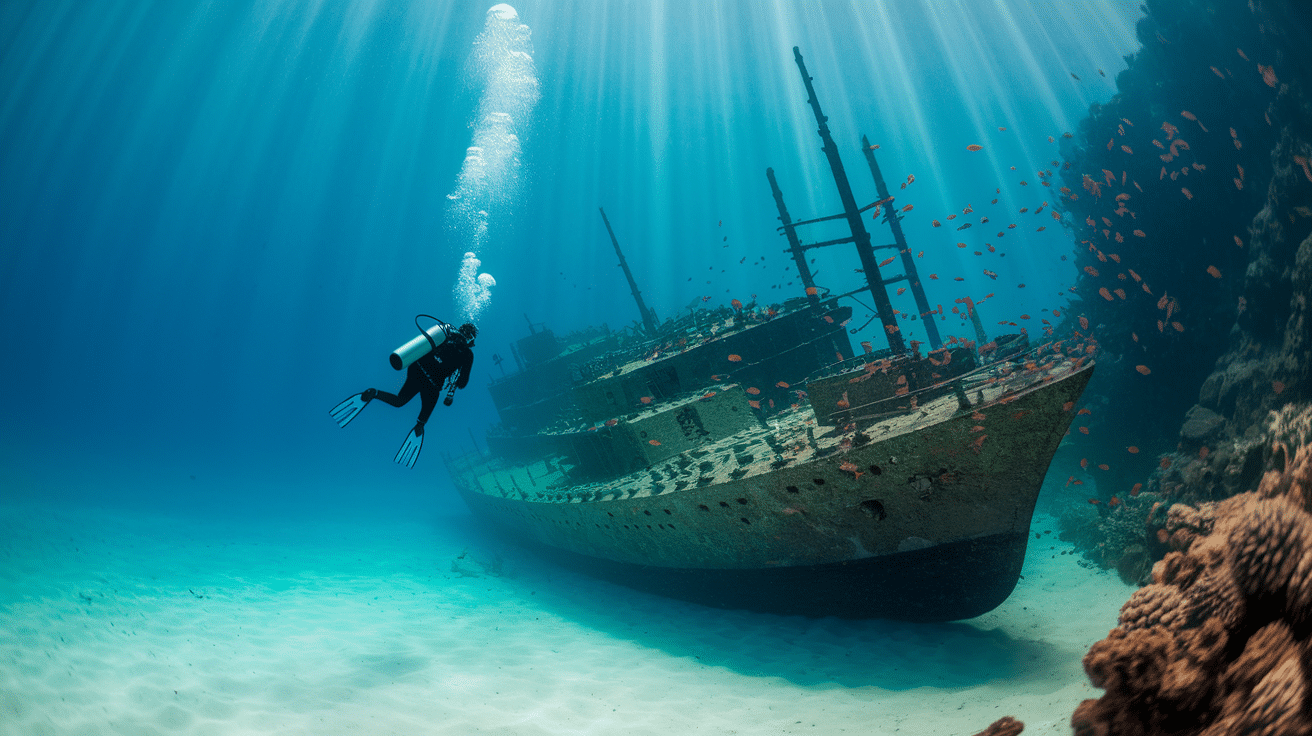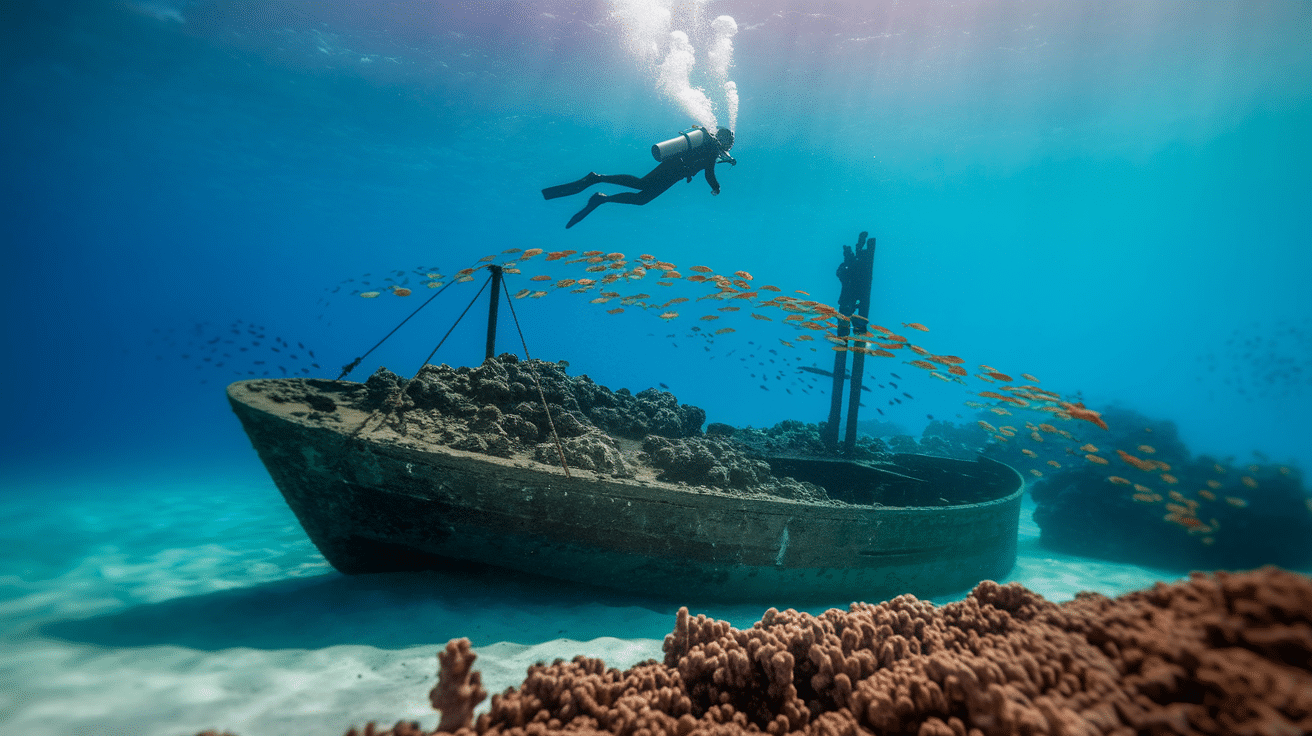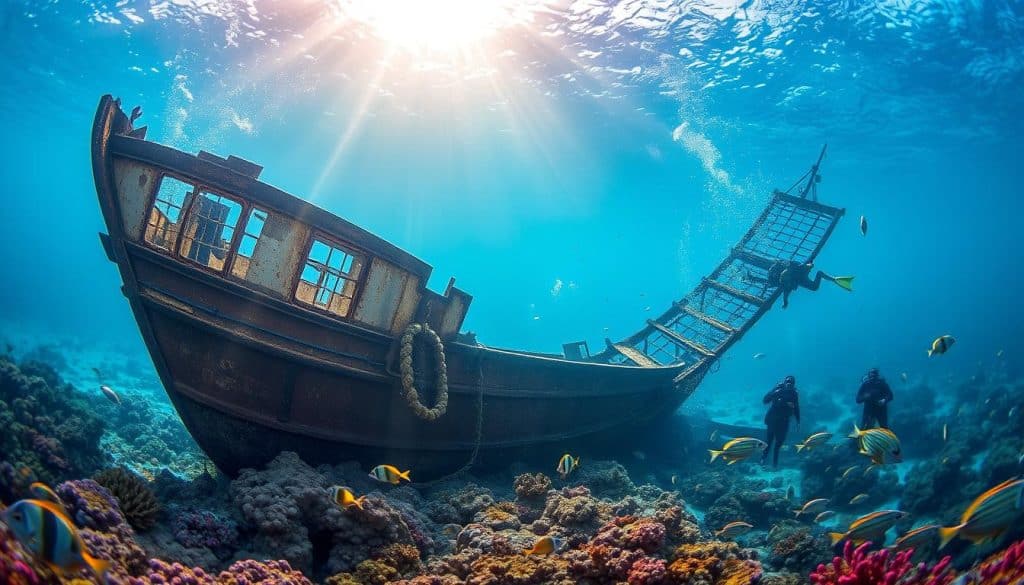Did you know the Maldives is home to over 1,000 stunning coral islands? Among them lies one of the world’s most thrilling dive sites—the Victory Wreck. This sunken cargo ship, resting just 35 meters below the surface, is now a thriving hub for marine life.
The crystal-clear waters of this tropical country offer unmatched visibility, making it a paradise for divers. Schools of colorful fish, reef sharks, and even manta rays weave through the wreck’s rusted corridors. It’s an underwater adventure like no other.
Whether you’re a beginner or an expert, the archipelago’s warm currents and vibrant coral ecosystems make every dive unforgettable. Ready to explore? Here’s what to expect when diving into history beneath the waves.
Introduction: The Allure of Maldives Shipwreck Diving

Imagine descending into crystal-clear waters where history meets marine wonder. The Maldives isn’t just a travel hotspot for overwater bungalows—it’s a playground for divers seeking adventure beneath the waves.
Sunken ships here transform into bustling artificial reefs. Corals cling to rusted hulls, while schools of angelfish and barracuda dart through hidden passages. It’s nature’s way of recycling history into vibrant ecosystems.
Beyond the wrecks, the nation’s white sands and turquoise lagoons set the stage for epic dives. Divers often spot reef sharks patrolling the depths or manta rays gliding past like underwater ballet dancers.
|
Wreck Diving |
Reef Diving |
|---|---|
|
Explores human-made structures |
Focuses on natural coral formations |
|
Rich in historical intrigue |
Teeming with endemic species |
|
Often deeper (30m+) |
Shallow (5–20m), ideal for beginners |
For thrill-seekers, wreck diving is the ultimate test of skill and curiosity. Every descent reveals secrets—a captain’s wheel encrusted in sponges or a cargo hold now home to lobsters.
Ready to trade palm trees for portholes? The Maldives’ underwater museums await.
Why the Maldives Is a Diver’s Paradise
With 26 atolls, the country offers endless diving possibilities. Its coral reefs burst with life, from playful parrotfish to sleek reef sharks. Protected marine areas ensure these ecosystems thrive, making every dive a vibrant encounter.
Rich Marine Biodiversity
The warm waters (79-86°F) act as a magnet for marine species. Schools of angelfish dart through coral labyrinths, while manta rays glide gracefully in deeper channels. Over 1,000 fish species call these reefs home.
Year-Round Diving Conditions
Visibility stretches up to 100 feet, perfect for exploring. November to April brings calm currents, ideal for beginners. From May to October, plankton blooms attract majestic mantas—a spectacle for seasoned divers.
Luxury resorts elevate the experience with expert-guided dive packages. Whether you’re snorkeling shallow reefs or wreck diving, the travel adventure is seamless. Conservation efforts ensure these waters remain pristine for generations.
Top Shipwreck Dive Sites in the Maldives
Beneath the waves of this tropical paradise lie sunken giants waiting to be explored. These wrecks, now teeming with marine life, rank among the top dive places for adventurers. Each offers a unique blend of history and underwater spectacle.
The Victory Wreck: A Deep-Sea Adventure
Sunk in 1981, the 110-meter cargo ship rests at 115–130 feet. Strong currents and depth make this an advanced-level dive. Schools of batfish and barracuda weave through its rusted hull, while occasional reef sharks patrol the area.
Maldives Victory: A Coral-Covered Gem
Shallower (50–100 feet) and encrusted with soft corals, this wreck is a must-visit for divers. Lionfish and moray eels hide in its crevices, creating a photographer’s dream. Its proximity to Malé makes it easily accessible.
For the ultimate experience, pair wreck dives with nearby reef explorations. The contrast between human history and natural beauty is unforgettable.
Preparing for Your Dive
Preparation is key for an unforgettable wreck diving experience in tropical waters. Timing, gear, and certifications ensure safety and maximize adventure. Here’s what divers need to know before plunging into history.
Best Time to Dive
November to April offers calm seas and visibility up to 100 feet. These months are ideal for beginners exploring shallower wrecks. From May to October, plankton blooms attract mantas, but stronger currents suit advanced divers.
|
Season |
Conditions |
Recommended For |
|---|---|---|
|
Nov–Apr |
Calm waters, high visibility |
Beginners & reef dives |
|
May–Oct |
Strong currents, plankton blooms |
Advanced wreck dives |
Essential Gear and Certifications
A dive computer, underwater torch, and reef-safe sunscreen top the packing list. For deeper wrecks like the Victory, an Advanced Open Water certification is mandatory. Luxury resorts with PADI-certified guides streamline the experience.
Pro tip: Many travelers book a Maldives package that includes luxury resort stays and guided wreck dives, making it easy to explore underwater treasures like the Victory Wreck with expert support.
What to Expect During the Dive

Every wreck dive in this island nation begins with anticipation and careful planning. Divers gather for a detailed briefing, reviewing depth limits, entry points, and potential hazards. The descent along an anchor line feels like unraveling a mystery—one rusted beam at a time.
Navigating the Wreck
Strong currents often guide divers through the wreck’s skeletal remains. Coral-coated railings and portholes shimmer under dive lights, but touching them risks damaging fragile ecosystems—and yourself. Experienced guides point out hidden artifacts: ceramic tiles from the ship’s galley or an engine part now home to lobsters.
Encounters with Marine Life
The wreck pulses with activity. Schools of snapper dart through cargo holds, while eagle rays glide overhead like silent shadows. Night dives reveal bioluminescent plankton and nocturnal hunters like octopuses. For travel enthusiasts, spotting a white-tip reef shark patrolling the wreck’s perimeter is the ultimate thrill.
- Typical Dive Sequence: Briefing → Controlled descent → Exploration of decks/holds → Safety stop.
- Don’t: Touch coral or disturb artifacts—preserve the site for future divers.
- Common Sightings: Batfish, moray eels, and occasional tuna.
Safety Tips for Wreck Diving in the Maldives
Safety first—wreck diving demands preparation and respect for the ocean’s power. This country’s underwater treasures are breathtaking, but strong currents and deep wrecks require caution. Follow these guidelines to explore confidently.
Choosing a Reputable Dive Operator
Not all operators meet safety standards. Verify their PADI or SSI affiliation and ask about emergency protocols. A reliable guide will review equipment checks and dive plans thoroughly.
|
Criteria |
Reputable Operator |
Red Flags |
|---|---|---|
|
Certifications |
PADI/SSI-affiliated |
No visible credentials |
|
Safety Record |
Transparent incident reports |
Vague answers |
|
Group Size |
Small (4–6 divers) |
Overcrowded boats |
Understanding Currents and Depth
Monsoon seasons (May–October) bring strong currents—ideal for drift diving but risky for beginners. Always check depth limits; wrecks like the Victory exceed 100 feet. DAN insurance is wise for medical evacuation coverage.
Buoyancy control protects corals and visibility. Stirring sediment obscures wreck details and harms ecosystems. Dive with a buddy and respect no-touch rules—history underwater is fragile.
Beyond the Wreck: Other Maldives Dive Experiences
Beyond rusted hulls, vibrant reefs and majestic sea creatures steal the spotlight. The archipelago’s waters are a living mosaic, where coral gardens and pelagic giants create unforgettable moments.
Thriving Coral Reefs
House reefs at resorts like Baros Maldives offer easy access for beginners. Soft corals sway in currents, while clownfish dart between anemones. Night snorkeling reveals bioluminescent plankton and octopuses hunting under moonlight.
Travelers can join coral restoration projects, helping rebuild damaged ecosystems. Fragments are nurtured in underwater nurseries before being transplanted to reefs—a hands-on way to protect these places.
Manta Ray and Shark Encounters
Hanifaru Bay, a *UNESCO Biosphere Reserve*, hosts seasonal manta ray feedings. From May–November, hundreds gather to feast on plankton, spiraling like underwater tornadoes.
Fuvahmulah Island is famed for tiger shark sightings. These rare predators patrol deep channels, offering thrilling encounters for advanced divers.
|
Experience |
Best Time |
Skill Level |
|---|---|---|
|
Manta Ray Snorkeling |
May–Nov |
Beginner |
|
Tiger Shark Dives |
Year-round |
Advanced |
|
Coral Restoration |
Any |
All levels |
Pro tip: Book a liveaboard to explore remote atolls. These multi-day trips combine wrecks, reefs, and rare species for the ultimate dive safari.
Planning Your Trip: Logistics and Resorts
Diving into the underwater world requires smart trip planning. Choosing the right resort and understanding entry rules ensure a seamless adventure. Here’s what travelers need to know before packing their fins.
Top Dive-Friendly Resorts
Luxury meets convenience at these top picks:
- Conrad Maldives Rangali Island: Overwater villas with private dive centers. Perfect for couples seeking romance and reef access.
- Kuredu Resort: A house reef just steps from your room. Ideal for beginners and families.
|
Resort |
Best For |
Dive Highlights |
|---|---|---|
|
Conrad Rangali |
Luxury & couples |
Private dive yacht, manta ray trips |
|
Kuredu |
Beginners & families |
Shallow house reef, PADI courses |
Entry Requirements and Insurance
U.S. passport holders get a 30-day visa on arrival, provided passports are valid for six months. COVID-19 protocols may change, so check updates before flying.
Travel insurance is critical. Policies should cover:
- Emergency evacuation (DAN Insurance recommended)
- Dive equipment loss
- Trip interruptions
Pro tip: Book seaplane transfers early—they have strict 55-pound baggage limits. Liveaboards offer more dive flexibility but require advanced planning.
Conclusion: A Dive You’ll Never Forget
Few dive destinations merge luxury and underwater thrills like these islands. The nation’s shipwrecks offer a rare mix of history and vibrant marine life, from barracuda darting through hulls to manta rays gliding past coral towers.
Plan ahead—peak seasons (December–March) fill fast. Resorts with PADI-certified guides ensure seamless adventures, whether you’re a beginner or advanced diver.
Share your wreck diving stories with #MaldivesMagic. Every visit supports marine conservation, helping protect these ecosystems for future explorers.
Ready to turn travel dreams into reality? Pack your gear and dive into an unforgettable underwater journey.





















